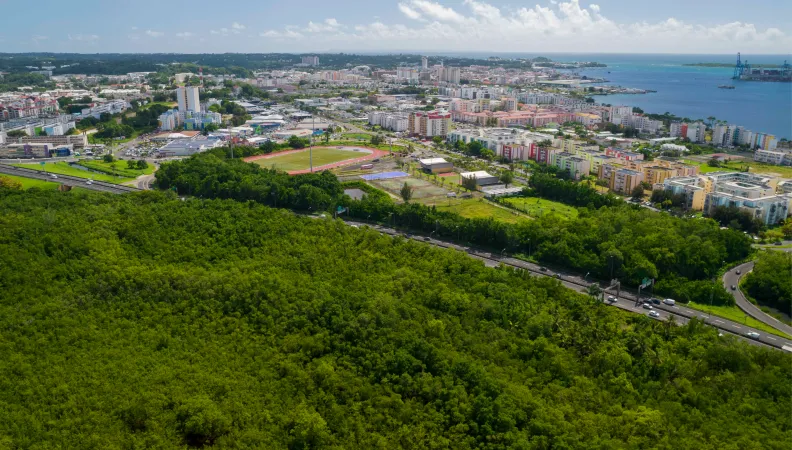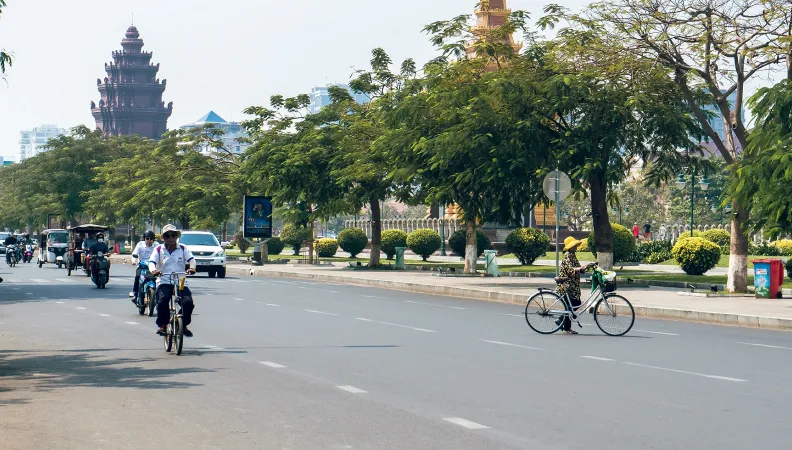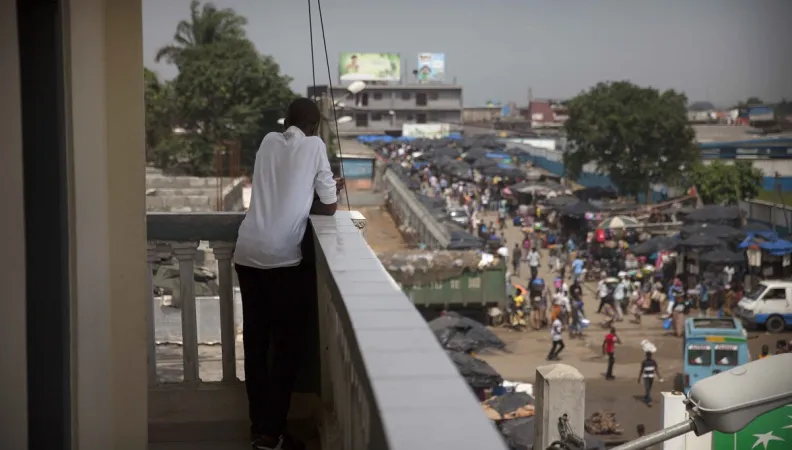 The CEROM (Comptes économiques rapides pour l'Outre-mer - Fast Economic Accounts for Overseas France) partnership brings together complementary expertise from the French National Institute of Statistics and Economic Studies (INSEE), the Monetary Issuing Institutes (IEOM/IEDOM) and Agence Française de Développement (AFD) to strengthen existing statistical information on French Overseas Territories, and, above all, to better promote it. After 20 years of existence, CEROM's work is widely known in French Overseas Territories and provides valuable support for the management of public policies.
The CEROM (Comptes économiques rapides pour l'Outre-mer - Fast Economic Accounts for Overseas France) partnership brings together complementary expertise from the French National Institute of Statistics and Economic Studies (INSEE), the Monetary Issuing Institutes (IEOM/IEDOM) and Agence Française de Développement (AFD) to strengthen existing statistical information on French Overseas Territories, and, above all, to better promote it. After 20 years of existence, CEROM's work is widely known in French Overseas Territories and provides valuable support for the management of public policies.
Context
In the early 2000s, economists and statisticians from the institutions that are part of the CEROM project realized that important and high-quality statistical information on Overseas Territories existed, but that it was relatively unknown and under-exploited.
The first priority of the partnership has been to produce rapid economic accounts. The economic accounts of year n are now available in the second half of year n+1, while, before, they were only available in year n+3. Having this information earlier facilitates the analysis and economic management of the territories concerned.
Goal
The CEROM partnership aims to improve the economic information and macroeconomic analysis capacity of the French Overseas Territories, notably through:
- The construction of economic models adapted to these territories, allowing the production of rapid accounts on the basis of existing economic accounting;
- The development of cyclical indicators giving a quick overview of economic developments;
- The promotion of economic analysis of overseas collectivities and territories, by exploiting untapped data and in order to make this analysis accessible to the greatest number (production of macroeconomic balance sheets, short-term or thematic studies);
- The construction of a peers network to exchange good practices and compare methods;
- Strengthening the quality of the economic information system by bringing together statisticians, economists and users of economic data.
This partnership has also made it possible to measure for the first time the GDP of certain overseas collectivities and to produce a fine analysis of the corporate fabrics of several territories.
Method
The CEROM partnership derives from a framework agreement renewed since 2005 between the partner institutions. This agreement sets out the objectives and modalities for implementing the partnership.
The partnership is managed by partner institutions at headquarters level, and is represented locally through their offices in seven overseas territories: the five overseas departments, French Polynesia and New Caledonia. The partnership also covers other overseas communities: Wallis and Futuna, Saint-Pierre and Miquelon, Saint-Martin and Saint-Barthélemy.
The scope of the CEROM partnership is the production of economic information and databases enabling the monitoring of overseas economies, analysis and perspective of existing macroeconomic information.
Partner institutions produce economic statistics and analyses to inform public policies. The evaluation of public policies or projects, the development of programmes and development strategies have so far been beyond the scope of CEROM’s work.
Results
Partner institutions of CEROM work together on:
- The production and publication of economic studies (macroeconomic reports, sectoral studies, etc.);
- The construction of rapid economic accounts;
- The development of cyclical dashboards.
Publications from the partnership can be found on the CEROM website (in French).
In addition, every two to three years, AFD organizes with its partners a conference devoted to socio-economic or environmental issues in Oversees France. The seventh edition of these conferences was held on October 13, 2022, and dedicated to the following theme: Overseas Territories in transitions, challenges and visions of the future.
Lessons learned
Confirming the initial diagnosis that motivated its launch, the CEROM partnership shows that important statistical socio-economic information exists in the Overseas Territories, but that it was and still remains insufficiently mobilized, especially in academic circles. The use of available statistical data sources has enabled many studies to be produced over the last twenty years. However, this work presupposes taking into account the specificities and sometimes the limits of the different data sources, whether they come from INSEE, the departmental statistical services or the monetary issuing institutes.
Contacts:
- Bertrand Savoye, research officer, AFD
- Stéphanie Margot, Head of the Strategy and Transversal Support Unit, Three Oceans Department, AFD
 Cambodia is one of the 60 countries followed by AFD’s country-risk economists, whose assessments shed light on countries' economic trajectory and macroeconomic and financial situation.
Cambodia is one of the 60 countries followed by AFD’s country-risk economists, whose assessments shed light on countries' economic trajectory and macroeconomic and financial situation.
Context
AFD has been present in Cambodia since 1993 and supports the country by focusing on two key structural areas: promoting balanced territorial development (access to basic services, water resource management, adaptation to climate change, etc.) on the one hand and supporting the productive sector while respecting environmental and social standards (renewable energies, technical and professional training) on the other.
Goal
Produced by AFD's team of country-risk economists, macroeconomic country assessments provide an analysis of development processes in countries in which AFD operates. They also characterize their growth trajectory, and detect economic, social, political and financial vulnerabilities associated with these trajectories. AFD Group is thus in a position to properly measure the challenges and monitor the risks associated with each of its investments.
Emphasis is placed on developing countries, particularly in Africa, for which macroeconomic analyses are rare or infrequent. AFD seeks to complement existing production on the global economic situation, more focused on advanced economies and major emerging countries.
Find out more: Macroeconomic Analyses at AFD
Method
Country-risk analysis is based on a close follow-up over a long period of time and rooted in a fine knowledge of local contexts. Cyclical trends, often highlighted in the news, are always examined in the light of structural trends and of the regional context in which they take place. The aim is to highlight country-specific macroeconomic issues while assessing risks against comparable time- and space-based trajectories.
Country-risk economists place the study of socio-political vulnerabilities, the growth model, the viability of public debt, external balances and the soundness of the financial system at the heart of their assessment, and give specific attention to countries' exposure to climate risks.
Lessons learned
For two decades, Cambodia has been experiencing a gradual transformation enabling it to achieve significant economic and social progress and become a lower-middle-income country (LMIC). However, the various exogenous shocks since 2020 have underscored the fragile nature of the progress achieved and highlighted the challenges the country still needs to address to improve its socioeconomic environment, accelerate its economic growth and make it more inclusive, so that it can definitively leave the category of least developed countries.
Our publications on Cambodia's macroeconomic situation:
- "Cambodia: Significant progress towards sustainable economic growth", in MacroDev Semestrial Panorama n°44, July 2023
Contact:
- Laura Marie, country-risk economist at AFD
 Côte d'Ivoire is one of the 60 countries followed by AFD’s country-risk economists, whose assessments shed light on countries' economic trajectory and macroeconomic and financial situation.
Côte d'Ivoire is one of the 60 countries followed by AFD’s country-risk economists, whose assessments shed light on countries' economic trajectory and macroeconomic and financial situation.
Context
Côte d'Ivoire, the leading regional power in West Africa, aims to become an emerging country by 2020. To do this, it must reduce the poverty and inequality affecting its population and take all the necessary steps to promote youth employment. As a long-standing partner of Côte d'Ivoire, AFD supports it in carrying out key transitions for its future: demographic, social, energy, etc.
Goal
Produced by AFD's team of country-risk economists, country assessments provide an analysis of development processes in countries in which AFD operates. They also characterize their growth trajectory, and detect economic, social, political and financial vulnerabilities associated with these trajectories. AFD Group is thus in a position to properly measure the challenges and monitor the risks associated with each of its investments.
Emphasis is placed on developing countries, particularly in Africa, for which macroeconomic analyses are rare or infrequent. AFD seeks to complement existing production on the global economic situation, more focused on advanced economies and major emerging countries.
Find out more: Macroeconomic analyses at AFD
Method
Country-risk analysis is based on a close follow-up over a long period of time and rooted in a fine knowledge of local contexts. Cyclical trends, often highlighted in the news, are always examined in the light of structural trends and of the regional context in which they take place. The aim is to highlight country-specific macroeconomic issues while assessing risks against comparable time- and space-based trajectories.
Country-risk economists place the study of socio-political vulnerabilities, the growth model, the viability of public debt, external balances and the soundness of the financial system at the heart of their assessment, and give specific attention to countries' exposure to climate risks.
Lessons learned
Since emerging from its “lost decade” (2000-2010), Côte d'Ivoire has enjoyed strong economic growth (+7.2% since 2012). Resilient in the face of successive external shocks, it has confirmed its position within the WAEMU. A lower-middle-income country, it aspires to join the upper bracket by 2030. To achieve this, the economy, which is still largely based on commodity exports, faces a number of challenges, including restoring fiscal and external balance. Investment needs remain high to overcome persistent socio-economic fragilities and build an inclusive growth model. Despite good economic performance, the country remains vulnerable to political and security risks.
Our publications on Côte d'Ivoire's macroeconomic situation:
-
"Côte d’Ivoire: Macro-financial resilience and pursuit of an emerging ambition" in MacroDev n°60 (February 2025)
- "Race towards emergence challenged by shocks" in MacroDev Semestrial Panorama n°53 (February 2024)
- "Côte d’Ivoire: a relatively resilient economy", in MacroDev Semestrial Panorama n°36 (September 2021)
- "Debt sustainability in Africa: state of play and future challenges", MacroDev n°34 (May 2021)
- "Les enjeux de la nouvelle croissance ivoirienne" (October 2015, in French)
Contact:
- Laura Marie, country-risk economist at AFD
 Brazil is one of the 60 countries followed by AFD’s country-risk economists, whose assessments shed light on countries' economic trajectory and macroeconomic and financial situation.
Brazil is one of the 60 countries followed by AFD’s country-risk economists, whose assessments shed light on countries' economic trajectory and macroeconomic and financial situation.
Context
In line with the international agenda on sustainable development and combating climate change, AFD is supporting Brazil on its path towards low-carbon, resilient and equitable development, leveraging its financial instruments to support regional development players.
Goal
Produced by AFD's team of country-risk economists, country assessments provide an analysis of development processes in countries in which AFD operates. They also characterize their growth trajectory, and detect economic, social, political and financial vulnerabilities associated with these trajectories. AFD Group is thus in a position to properly measure the challenges and monitor the risks associated with each of its investments.
Emphasis is placed on developing countries, particularly in Africa, for which macroeconomic analyses are rare or infrequent. AFD seeks to complement existing production on the global economic situation, more focused on advanced economies and major emerging countries.
Find out more: Macroeconomic analyses at AFD
Method
Country-risk analysis is based on a close follow-up over a long period of time and rooted in a fine knowledge of local contexts. Cyclical trends, often highlighted in the news, are always examined in the light of structural trends and of the regional context in which they take place. The aim is to highlight country-specific macroeconomic issues while assessing risks against comparable time- and space-based trajectories.
Country-risk economists place the study of socio-political vulnerabilities, the growth model, the viability of public debt, external balances and the soundness of the financial system at the heart of their assessment, and give specific attention to countries' exposure to climate risks.
Lessons learned
Our publications on Brazil's macroeconomic situation:
- "Brazil: Beware of own goals", in MacroDev Semestrial Panorama n°44 (July 2023)
- "Brazil: a short-lived lull", in MacroDev Semestrial Panorama n°41 (February 2022)
- "Où en est l’économie brésilienne ?" (April 2014, in French)
Contact:
- Maxime Terrieux, country-risk economist at AFD
